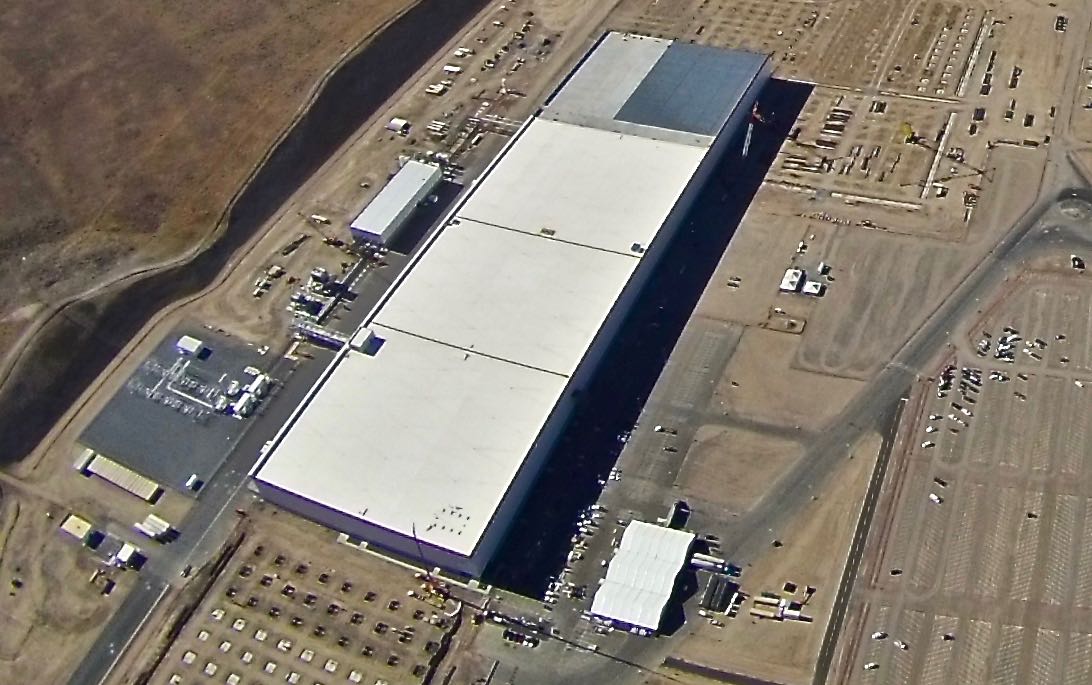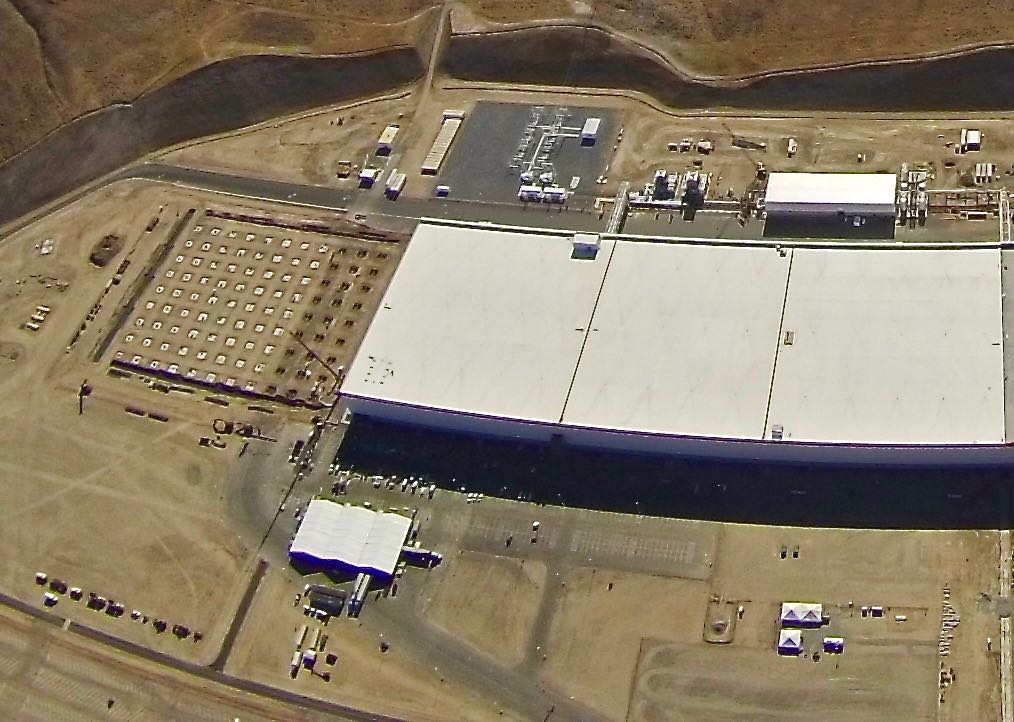News
New Tesla Gigafactory projects revealed through latest building permits

Teslarati has learned that the total value of all building permits issued for the Tesla Gigafactory now stands at $386 million, or $63 million more than the last time Jack Cookson of BuildZoom checked in with the local building inspector’s office.
Perhaps the most surprising bit of information is that a permit was issued recently for a “temporary tent structure” for a “special event” costing $300,000 likely to be used for the Gigafactory Grand Opening party. We recently spotted the massive tent, the size of two NBA basketball courts, in newly captured aerial photos of the Gigafactory.
“Section F Expansion” assumed to be one of the two new additions at the battery plant claimed the largest single permit by dollar at $22 million. There was also a permit issued for “seismic anchoring” totaling $9.4 million. Presumably, seismic anchoring is part of the foundation work for Section F.
We have to keep reminding ourselves that the current building represents less than 15% of the total size of the Gigafactory when finished. All the exterior walls except the main wall in front are temporary, designed to be broken through as new sections are added.
We’ve provided all of the notable permits filed for the Tesla Gigafactory via BuildZoom.
- The total value of work since we last checked in has been 63 million dollars, bringing the total for the entire project to 386 million dollars.
- First, and perhaps most relevant to the opening, is on July 18th Tesla filed a permit for a “temporary tent structure” for a “special event”. While I can’t be sure, the $300,000 tent might be for the grand opening.
- The biggest single permit was a 22 million dollar permit for the “Section F Expansion”.
- The first permits related to Panasonic work were issued to Tesla on June 28th and July 13th. The two permits are for the installation of Panasonic tools. The two permits were both designated to section B/C and totaled 16.2 million dollars.
- There was also 14.4 million dollars worth of addenda to sections D/E.
- There was 9.4 million dollars in seismic anchoring issued in permits.
- There was 350,000 dollars across two permits for contractor lunch tents, perhaps related to the increase in construction workers they recently took on.
- There was also a parking expansion and while I don’t know what a “Nitrogen Yard” is there was a permit for one.
As Panasonic executive vice president Yoshihiko Yamada explained at the Tuesday news conference, his company is fully committed to its partnership with Tesla. Panasonic took out two building permits of its own recently, both covering the installation of its proprietary machines and tools in sections B and C. The two permits together total $16.2 million.
The local building inspector’s office also recorded permits totaling $14.4 million for additional work in Sections D and E and $9.4 million in other miscellaneous work recently. They include an expansion to the parking area. Tesla made sure there was parking for 2,000 cars in time for the grand opening this weekend.
The pace of construction at the Gigafactory is accelerating. Workers are now busy seven days a week, working two shifts a day. In order to accommodate their needs, Tesla has applied for permits for two contractor lunch tents worth a total of $350,000.
Finally, Jack Cookson reports a permit application for a “Nitrogen Yard.” Exactly what that is or what role it will play in the production process remains unclear.

News
Tesla FSD fleet is nearing 7 billion total miles, including 2.5 billion city miles
As can be seen on Tesla’s official FSD webpage, vehicles equipped with the system have now navigated over 6.99 billion miles.

Tesla’s Full Self-Driving (Supervised) fleet is closing in on almost 7 billion total miles driven, as per data posted by the company on its official FSD webpage.
These figures hint at the massive scale of data fueling Tesla’s rapid FSD improvements, which have been quite notable as of late.
FSD mileage milestones
As can be seen on Tesla’s official FSD webpage, vehicles equipped with the system have now navigated over 6.99 billion miles. Tesla owner and avid FSD tester Whole Mars Catalog also shared a screenshot indicating that from the nearly 7 billion miles traveled by the FSD fleet, more than 2.5 billion miles were driven inside cities.
City miles are particularly valuable for complex urban scenarios like unprotected turns, pedestrian interactions, and traffic lights. This is also the difference-maker for FSD, as only complex solutions, such as Waymo’s self-driving taxis, operate similarly on inner-city streets. And even then, incidents such as the San Francisco blackouts have proven challenging for sensor-rich vehicles like Waymos.
Tesla’s data edge
Tesla has a number of advantages in the autonomous vehicle sector, one of which is the size of its fleet and the number of vehicles training FSD on real-world roads. Tesla’s nearly 7 billion FSD miles then allow the company to roll out updates that make its vehicles behave like they are being driven by experienced drivers, even if they are operating on their own.
So notable are Tesla’s improvements to FSD that NVIDIA Director of Robotics Jim Fan, after experiencing FSD v14, noted that the system is the first AI that passes what he described as a “Physical Turing Test.”
“Despite knowing exactly how robot learning works, I still find it magical watching the steering wheel turn by itself. First it feels surreal, next it becomes routine. Then, like the smartphone, taking it away actively hurts. This is how humanity gets rewired and glued to god-like technologies,” Fan wrote in a post on X.
News
Tesla starts showing how FSD will change lives in Europe
Local officials tested the system on narrow country roads and were impressed by FSD’s smooth, human-like driving, with some calling the service a game-changer for everyday life in areas that are far from urban centers.

Tesla has launched Europe’s first public shuttle service using Full Self-Driving (Supervised) in the rural Eifelkreis Bitburg-Prüm region of Germany, demonstrating how the technology can restore independence and mobility for people who struggle with limited transport options.
Local officials tested the system on narrow country roads and were impressed by FSD’s smooth, human-like driving, with some calling the service a game-changer for everyday life in areas that are far from urban centers.
Officials see real impact on rural residents
Arzfeld Mayor Johannes Kuhl and District Administrator Andreas Kruppert personally tested the Tesla shuttle service. This allowed them to see just how well FSD navigated winding lanes and rural roads confidently. Kruppert said, “Autonomous driving sounds like science fiction to many, but we simply see here that it works totally well in rural regions too.” Kuhl, for his part, also noted that FSD “feels like a very experienced driver.”
The pilot complements the area’s “Citizen Bus” program, which provides on-demand rides for elderly residents who can no longer drive themselves. Tesla Europe shared a video of a demonstration of the service, highlighting how FSD gives people their freedom back, even in places where public transport is not as prevalent.
What the Ministry for Economic Affairs and Transport says
Rhineland-Palatinate’s Minister Daniela Schmitt supported the project, praising the collaboration that made this “first of its kind in Europe” possible. As per the ministry, the rural rollout for the service shows FSD’s potential beyond major cities, and it delivers tangible benefits like grocery runs, doctor visits, and social connections for isolated residents.
“Reliable and flexible mobility is especially vital in rural areas. With the launch of a shuttle service using self-driving vehicles (FSD supervised) by Tesla in the Eifelkreis Bitburg-Prüm, an innovative pilot project is now getting underway that complements local community bus services. It is the first project of its kind in Europe.
“The result is a real gain for rural mobility: greater accessibility, more flexibility and tangible benefits for everyday life. A strong signal for innovation, cooperation and future-oriented mobility beyond urban centers,” the ministry wrote in a LinkedIn post.
News
Tesla China quietly posts Robotaxi-related job listing
Tesla China is currently seeking a Low Voltage Electrical Engineer to work on circuit board design for the company’s autonomous vehicles.

Tesla has posted a new job listing in Shanghai explicitly tied to its Robotaxi program, fueling speculation that the company is preparing to launch its dedicated autonomous ride-hailing service in China.
As noted in the listing, Tesla China is currently seeking a Low Voltage Electrical Engineer to work on circuit board design for the company’s autonomous vehicles.
Robotaxi-specific role
The listing, which was shared on social media platform X by industry watcher @tslaming, suggested that Tesla China is looking to fill the role urgently. The job listing itself specifically mentions that the person hired for the role will be working on the Low Voltage Hardware team, which would design the circuit boards that would serve as the nervous system of the Robotaxi.
Key tasks for the role, as indicated in the job listing, include collaboration with PCB layout, firmware, mechanical, program management, and validation teams, among other responsibilities. The role is based in Shanghai.
China Robotaxi launch
China represents a massive potential market for robotaxis, with its dense urban centers and supportive policies in select cities. Tesla has limited permission to roll out FSD in the country, though despite this, its vehicles have been hailed as among the best in the market when it comes to autonomous features. So far, at least, it appears that China supports Tesla’s FSD and Robotaxi rollout.
This was hinted at in November, when Tesla brought the Cybercab to the 8th China International Import Expo (CIIE) in Shanghai, marking the first time that the autonomous two-seater was brought to the Asia-Pacific region. The vehicle, despite not having a release date in China, received a significant amount of interest among the event’s attendees.









